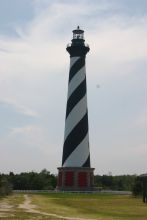
In many ways Hatteras Island is the Outer Banks. In its more than 50-mile length is wrapped up the things for which the Banks are famous: solitude and unspoiled nature. In the Pea Island National Wildlife Refuge, comprising the northern end of the island, you can drive for miles, hearing only the sea and the call of the wild geese, seeing only the dunes.
Farther south, you roll through the very stuff of Banks legend: tiny communities whose whole livelihood came from the sea. From Rodanthe, Waves and Salvo the Bankers of the Life Saving Service battled storm and surf to save strangers’ lives. Today's visitor finds wrecks still on the beaches – and some of the best fishing on the Banks.
Some 40 miles south of Oregon Inlet, the island takes a westward turn, leaving Cape Point jutting out into the Atlantic. Here, at its elbow, is Cape Hatteras, feared for centuries by mariners as the Graveyard of the Atlantic. Here the century-old lighthouse still sends its warning beam seaward, and here surfers and surf fishermen find the acme of their sports.
Inland of the cape, at the widest part of the Banks, small communities have established themselves, nestled in the depths of a unique maritime forest. Buxton and Frisco offer camping, shopping, restaurants, tackle shops and a chance to stock up on supplies before continuing south.
Hatteras Village, close to the western end of the island at the ferry terminus for Ocracoke, has long been a mecca for sport fishermen and vacationers.
Most of Hatteras Island is part of Cape Hatteras National Seashore and is administered by the National Park Service (though Pea Island National Wildlife Refuge is administered by U.S. Fish and Wildlife Service). This provides for the preservation of most of the island. A well-kept series of park service campgrounds, swimming beaches, beach access facilities and a visitor center at the Cape Hatteras Lighthouse provide for the convenience of visitors. These are supplemented by numerous private campgrounds, motels and accommodations.
In the early years, the islanders lived cut off from others, evolving their own microculture, preserving old ways of speech and suspicion of authority. Since 1964 the Herbert C. Bonner Bridge over Oregon Inlet has largely ended that isolation. Yet traces of it linger, and you will find Hatteras different from Kitty Hawk and Nags Head. There are no fast food outlets, no movie theatre, only one stoplight. The Hatteras people are friendly, but they don't accept outsiders immediately. Their villages, their economy, are geared to the summer visitor trade, but still with reservations, as if this, too, may be a passing thing. Living on shifting sand, alone and isolated all winter, and knowing that any summer the hurricanes can change everything, even the shape of the land, the Hatteras people learn to trust only themselves and the eternal sea.
No visitor to the Outer Banks should miss the southern islands, Hatteras and Ocracoke. There you will find, still strong, something increasingly rare in the modern world: Independence.
Rodanthe, Waves and Salvo
Rodanthe, Waves and Salvo are small communities of perhaps one to two hundred people each ... during the winter. In summer they blossom with thousands of visitors streaming south on Highway 12. Many visitors stop, and discover these tiny towns ... but too many drive by, intent on getting to storied Hatteras Village or Ocracoke. But if you like fishing, Rodanthe has the Rodanthe Pier. If you like wrecks, this is where they lie, to be covered and uncovered with each winter's storms. If you like watersports, two of the biggest kiteboarding schools on the Outer Banks are here. History buffs should stop at the Chicamacomico Lifesaving Station Historic Site. And if you're a camper, there are half a dozen places to stay, probably the biggest concentration of camping sites in the Banks. This is a beautiful, relatively undeveloped area, and development boom has hit.
Avon
Avon, the last town on the northern arm of the island before the run through Park Service-owned territory to the cape, is 30 miles south of Oregon Inlet. Once remote, it has become much more accessible since the opening of the Herbert Bonner Bridge, and now has a growing stream of tourists. It's still primarily a summer community, with tons of single-family cottages. One quiet summer evening, looking west over a mirror-like sound toward the setting sun, we understood why; there was at that moment no more beautiful place on the banks. The winter population is less than 800 but still growing. Avon is a hub of social life on the southern Banks, with the largest grocery store, the Avon Pier, a spac and fitness center, several popular restaurants/bars and watersports outfitters.
Buxton, Frisco and Hatteras Village
The southern "arm" of Hatteras Island – from the "elbow'' at the cape west and south toward Ocracoke – is more populated and more habitable than the op?n land to the north. More of it is privately owned, in contrast to the overwhelming proportion of National Seashore land on the rest of the island. Higher and more stable geologically, the southern arm is primarily a maritime forest habitat, often thick with live oak and red bay, dogwood and loblolly pine. It offers more shelter from wind and storm, and has borne a small and hardy population from the earliest Indian times. Historically, they made their living from the sea; supplanting this, many local people are still at least part-time commercial fishermen.
Buxton, just inland from Cape Hatteras itself, is a small and growing town of motels, campgrounds and permanent residents (around 1,275). The fishing flavor is strong here during the spring and fall seasons. Buxton is a mecca for sports fishermen and Atlantic Coast surfers. This is the largest of the Hatteras Island communities population-wise and is home to the island’s schools and Dare County recreation center.
A winding, pleasant road runs west from Buxton, through the forest, toward Frisco. On the way you will pass several attractive campgrounds and many roads leading back into new real estate developments, both on the ocean side and on the higher land overlooking the sound. Frisco is home to only 200 year-round residents, but it comes to life in the summer and fall with vacationers and fishermen. A few restaurants and shops serve their needs.
Hatteras Village, at the western tip of the island, is second only Wanchese as the Outer Banks’ center of commercial and recreational fishing activity. Sport fishing, for marlin and other big sport fish, is another Hatteras specialty. The Hatteras Marlin Tournament is perhaps the biggest single week in Hatteras Village. Upwards of 50 private boats fish in this prestigious tournament, hosted by the Hatteras Marlin Club. Hatteras’ year-round population is around 500, with the summer population swelling into the thousands.






